“Snowgaine is nothing short of epic. For athletes accustomed to long mileage but who have limited navigation experience, do not be deterred! A few excursions with your local orienteering club this summer will provide you with the experience necessary to set you on your way.That said, as far as snowshoe endurance events are concerned, Snowgaine is a must,” said Hannah Johnston, a convert to this unique style of competitive snowshoeing.
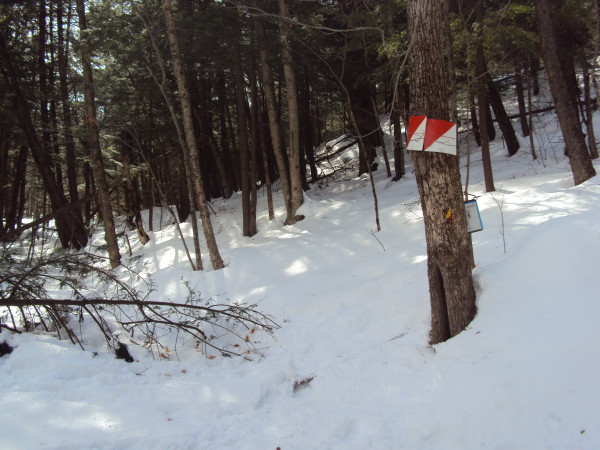
Control No. 22 consisting of a sign-in sheet and punch card
The possibilities and choices of enjoying snowshoes while competing continues expanding. The Williamstown, New York (about 45 minutes NE of Syracuse) SnowGaines Event celebrated their XIX edition this year, 2015, or MMXV if you’re counting Roman Numerals. Mark and Barb Dominie provide the enthusiasm for the races along with making the event happen in the first place.
The enthusiasm for the racers is described by Johnston, a geographer, mountain biker, and trail runner. “Over the past couple of years, endurance length sporting events have become increasingly popular. Within the mountain biking community, 100-mile races and 12 and 24-hour events are now commonplace; and among runners, ultra marathons seem to be springing up worldwide.” Consider the popularity of endurance events and the trend’s meaning for snowshoe enthusiasts:
“As the number of ultra events has grown, there has also been a proliferation of winter races. While a handful of these races are snowshoe specific competitions (Peak Races in Vermont, for example), there are a smaller number of races and events that let participants to choose their preferred mode of transportation. Snowgaine is one of these events.
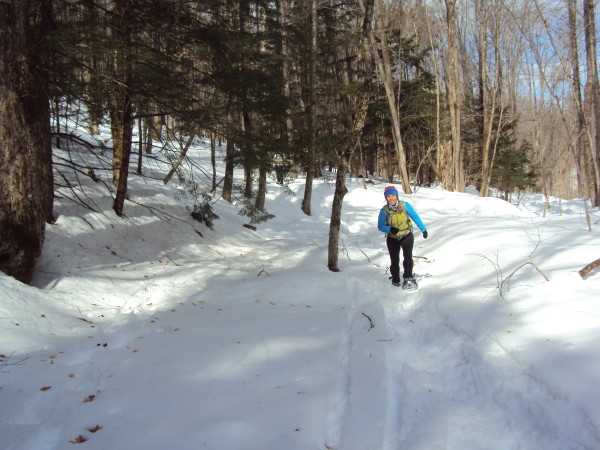
Gabriela Stephens making way to No. 22
During the weekend of March 8 & 9, two friends and I traveled to Berne, New York, in order to compete in the annual Snowgaine event. The name “Snowgaine” is a spoof off of the term “ROGAINE,” for Rugged Outdoor Group Activity Involving Navigation along with ultra-Endurance. Orienteering, though somewhat popular in Europe and various Commonwealth countries, is a relatively obscure sport in the United States. Clubs operate on a regional level and organize meets and races throughout the United States; Snowgaine is organized by the Central New York Orienteering club and this year was held in conjunction with the Empire Orienteering Club the event’s eighteenth year in existence.
Snowgaine takes place over two eight-hour days in an area that covers 200 square kilometers. Participants are permitted to use their preferred form of human-powered transportation. With over fifty controls (or self check-in locations) that vary in point value, teams are required to follow a route of their choosing with the goal of obtaining the largest possible score over sixteen hours of racing. While trails and roads are sometimes available for use, participants will often veer from established corridors, instead devising their own paths through the woods, across frozen rivers and lakes, and up and over mountains.
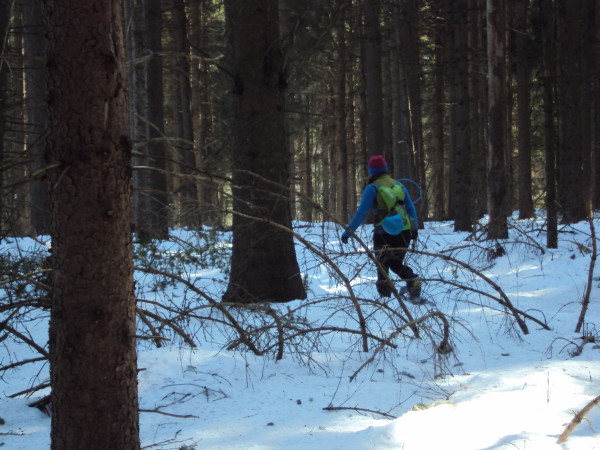
Late in the first day, Gabriela Stephens searches for the next control and 31 more points. The team’s diligence paid off with a silver medal finish in the women’s group.
On Saturday morning we were given a map indicating the location of the controls one hour before departure. At this time we quickly began considering the multitude of route possibilities. With well over a foot and a half of snow on the ground, and with the knowledge that we would be traversing unpacked trails and blazing our own, our team opted for snowshoes and running shoes as our preferred mode of transportation.
Over the next two days our team covered over 80 kilometers of ground and thousands of feet in elevation. More than half of this was done in snowshoes, which kept us afloat in the sea of snow and allowed us to run on more firmly packed snowmobile trails. Our team had little experience orienteering, but we found the controls to be well placed and relatively easy to find with the help of a compass and the detailed map provided by the race organizers. Unlike a traditional race where one follows a set course and is acutely aware of the location of their competitors, the structure of Snowgaine was such that we only occasionally crossed paths with other racers. As each team had developed their own strategy to obtain the highest score possible, we often saw only the tracks of our competition as we neared a control.
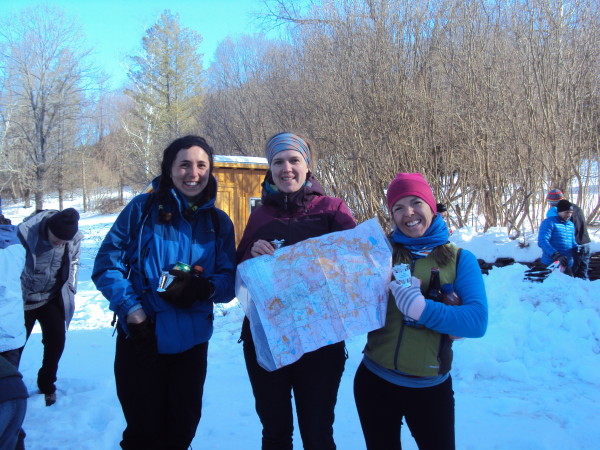
Team Sassafast celebrates their second place finish in the women’s category! Hannah Johnston (L), Sinead Earley, Gabriela Stephens
At the end of the first day, the race organizers tallied up the point accumulation and displayed the list of controls that other teams had visited. Then everyone can join in the “warm food” of hamburgers, chili, stew and other delights before calling it a day.
That evening we headed back to our hotel room to dry out our clothes; with maps in hand, we were able to spend what little energy we had left planning out our route for day two.
In total, fourteen teams participated. Winning teams consisted of serious athletes and experienced navigators, many of whom had competed in past years. By the end of day two, the top contenders successfully reached over thirty-five controls and amassed nearly 1,400 points of a possible 2,000. This was an impressive feat given the distance between controls and the topographical relief of the area.
A Beginner’s Guide: Top Ten Tips by John Godino, Portland, Oregon, and John Bartholomew provides incredible information for a Rogainer. Racers in the Columbia River Orienteering Club’s “Big Muddy,” (no, it’s not generally muddy at all) Godino serves as CROC’s President and webmaster. He provides details that can make you instantly mediocre in the sport, a big step-up from rank novice. To become proficient or even competitive, as Godino writes, requires “paying your dues and suffering through an event or two in order to discover for yourself what works and what doesn’t.” Why try? “There is something in the absolute bizarreness of this event (that) just grabs me on a gut level . . . go try this wacky sport for yourself.”
“Empire Orienteering Club and Central New York Orienteering did a great job putting on the race,” added Johnston. “They provided detailed maps and specific descriptions regarding the geographical features surrounding the controls. As such, we were able to move with relative ease through upstate New York’s beautiful landscapes. The race organizers opened their home and provide delicious meals at the end of each day. This gave us a chance to meet other racers and learn more about the sport.”
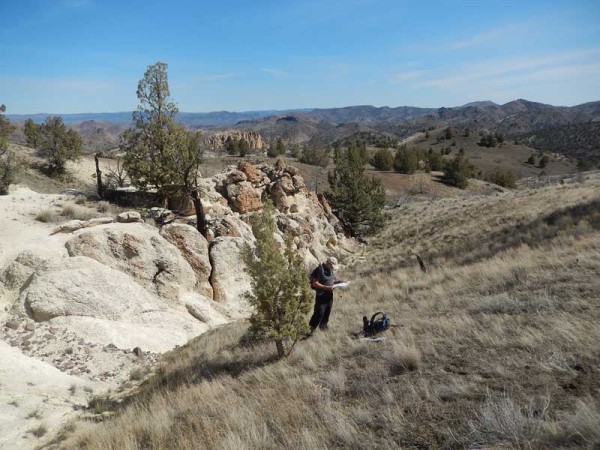
CROC’s “Mal Harding Memorial Big Muddy Navigation Race” near Portland, OR, at the Big Muddy Ranch. 2015’s race will have new terrain there for the event on May 24.
Godino allows himself to romanticize the time of trails as anyone who has competed in the woods will understand: “Enjoy the moments you’re out there. Hear the nighttime call of the owls and the dawn warble of the meadowlarks, be mesmerized by the wind’s rhythmic ripple in the tall spring grasses, take a moment to look into the center of the blooming wildflowers, admire the deer antler you found next to the water hole. A Rogaine is a unique experience and usually in a special landscape few people will ever see, let alone over an entire day and night. Remember and hold these small moments and memories, and you may find years later they are the most special.” He reminds all to train with this friendly refrain: Remember, “‘Any fool can skydive once.’ Come prepared, so you’ll have a good time and want to be back for your next Rogaine.”
Write: phillip@ultrasuperior.com

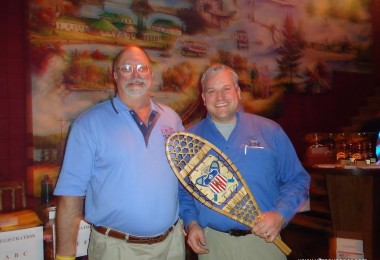
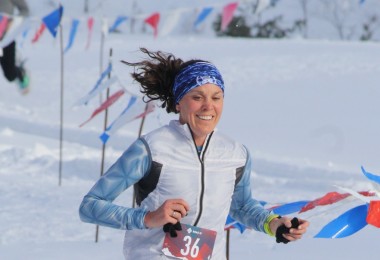
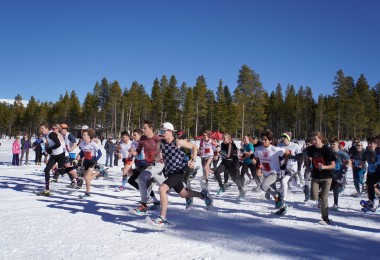
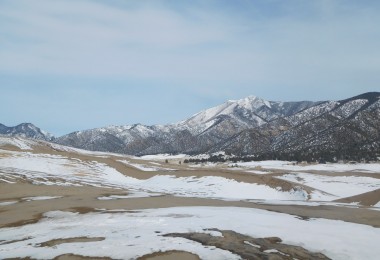

Leave a Comment